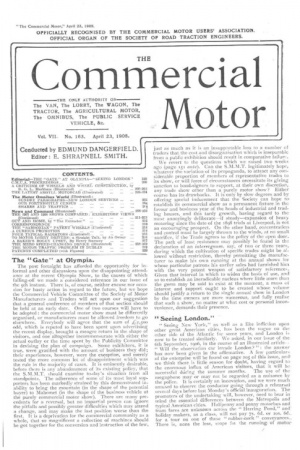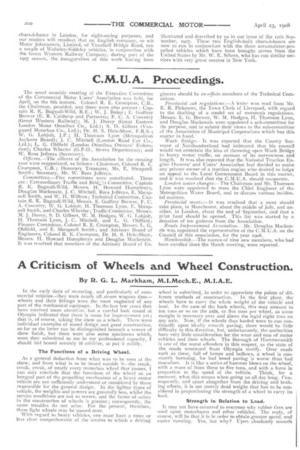The "Gate" at Olympia.
Page 1

Page 2

If you've noticed an error in this article please click here to report it so we can fix it.
The past fortnight has afforded the opportunity for informal and other discussions upon the disappointing attendance at the recent Olympia Show, to the causes of which falling-off we made a considered reference in our issue of the 9th instant. There is, of course, neither excuse nor occasion for hasty action in regard to the future, but we hope the Commercial Vehicle Committee of the Society of Motor Manufacturers and Traders will act upon our suggestion that a general conference of members of that section should be held at an early date. One of two courses will have to be adopted : the commercial motor show must be differently organised, or manufacturers must be allowed freedom to go elsewhere. Everybody will agree that the sum of ,2,500 odd, which is reputed to have been spent upon advertising the recent display, brought a.meagre return in the shape of visitors, and one altogether incOmmensurate with either the actual outlay or the time spent by the Publicity Committee in devising the plan of campaign. Some exhibitors, it is true, were gratified with the amount of lousiness they did; their experiences, however, were the exception; and merely tested the more common lot of disappointment which was the rule in the majority of cases. It is eminently desirable, before there is any abandonment of its existing policy, that the S.M.M.T. should examine to-day's situation from all standpoints. 'The adherence of some of its most loyal supporters has been markedly strained by this demonstrated inability to bring the mountain (in the shape of the potential buyer) to Mahomet (in the shape of the business vehicle at the purely commercial motor show). There are many precedents for a reversal, but no impartial person can ignore the pitfalls and possibly greater difficulties which may attend a change, and may make the last position worse than the first. It is a deprivation for the commercial community as a whole, that so magnificent a collection of machines should be got together for the conversion and instruction of the few, just as much as it is an insupportable loss to a number of traders that the cost and disorganisation which is inseparable from a public exhibition should result in comparative failure..
We revert to the questions which we raised two weeks ago (page 151 ante). Can the S.M.M.T. legitimately hope,. whatever the variation of its propaganda, to attract any considerable proportion of members of representative trades to its show, or will force of circumstances necessitate its giving sanction to band-signers to support, at their own discretion, any trade show other than a purely motor show? Either course has its drawbacks. It is only by slow degrees and by olTering special inducement that the Society can hope to establish its commercial show as a permanent fixture in the favour and business year of the heads of industrial and trading houses, and this tardy growth, having regard to the most annoyingly deliberate—if steady—expansion of heavy motoring since the date of the 1808 trials at Liverpool, is not an encouraging prospect. On the other hand, concentration, and control must be largely thrown to the winds, at no small sacrifice, if the Trade agrees to the policy of the open door. The path of least resistancemay possibly be found in the declaration of an interregnum, say, of two or three years, during which the cultivation of specific trades might be allowed without restriction, thereby permitting the manufacturer to make his own running at the annual shows for whose particular patrons his earlier sales had furnished him with the very potent weapon of satisfactory references. Given that interval in which to widen the basis of use, aml so to establish an ineradicable nucleus where little more than the germ may be said to exist at the moment, a mass ef interest and support ought to be created whose. volume should justify a return to the single annual show in London by the time owners are more numerous, and fully realise that such a show, no matter at what cost or personal inconvenience, demands their presence.
"Seeing London."
" Seeing New York," as well as a like infliction upon other great American cities, has been the vogue on the other side of the Atlantic for some years, and London is now to be treated similarly. We asked, in our issue of the 6th September, 1936, in the course of an illustrated article" Will the observation car invade London? " : the answer has now been given in the affirmative. A few particulars of the enterprise will be found on page 20,5 of this issue, and we think there is little reason for doubt, haying regard to the enormous influx of American visitors, that it will be successfulduring the summer months. The use of the megaphone may or may not be regarded as a nuisance by the police. It is certainly an innovation, and we were much amused to observe the conductor going through a rehearsal several days before last Monday's official inauguration. The promoters of the undertaking will, however, need to bear in mind the essential differences between the Metropolis and typical American cities. Halfpenny and penny motorbus and tram fares are unknown across the " Herring Pond," and' holiday makers, as aclass, will not pay 7s. 6d. or .005. 6d.. for a tour on one of these " rubber-neck " conveyances.. There is, none the less, scope lot the running 'of motor chars-à-bancs in London, for sight-seeing purposes, and our readers will recollect that an English company, to wit Motor Jobmasters, Limited, of Vauxhall Bridge Road, ran a couple of Wolseley-Siddeley vehicles, in conjunction with the Great Western Railway Company, during part of the 1907 season, the inauguration of this work having been illustrated and described by us in our issue of the 12th September, 1907. These two English-built chars-ft-bancs are now to run in conjunct;on with the three accumulator-propelled vehicles which have been brought across from the United States by Mr. W. E. Sebree, who has run similar services with very great success in New York.


























